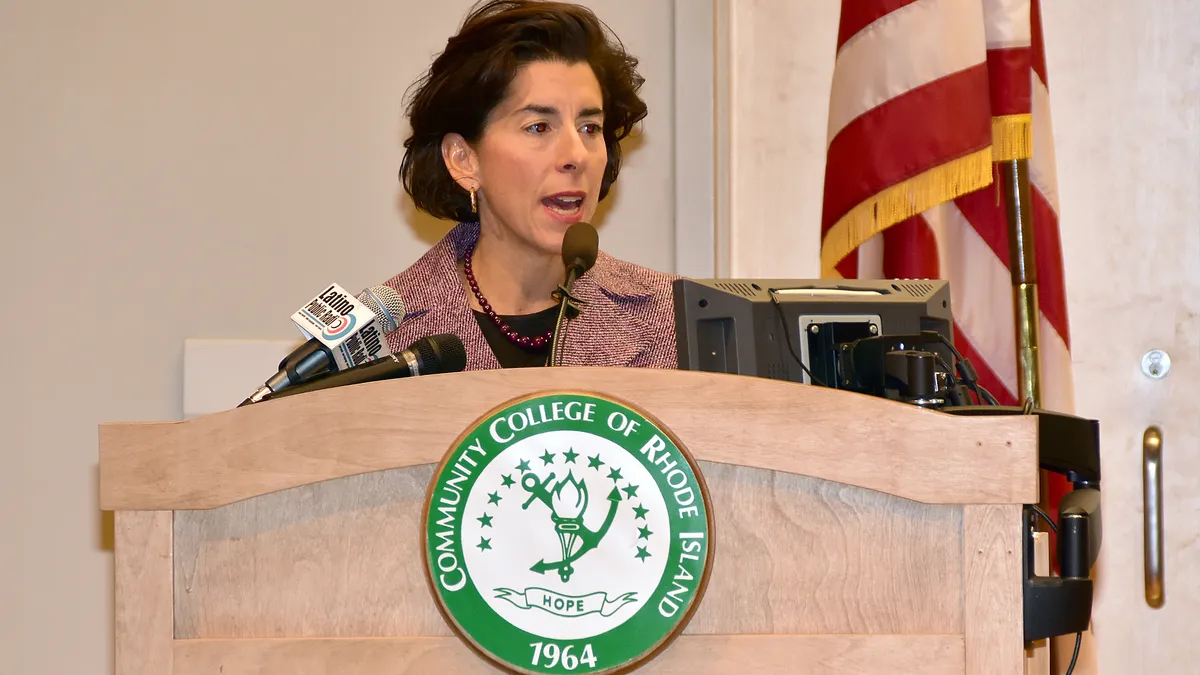Dive Brief:
- Rhode Island Gov. Gina Raimondo, D, signed an executive order on Friday directing the state's Office of Energy Resources to develop a plan for how the state can meet 100% of its electricity demand with renewable energy by 2030.
- The 2030 target is two years faster than what Washington, D.C., has enacted and between 10 and 20 years faster than what most other states with 100% clean energy goals have approved.
- A "specific and implementable" action plan is due to the governor by Dec. 31 and must include "recommended programmatic, legislative, and/or regulatory initiatives that can be advanced beginning in 2021," the order states.
Dive Insight:
Raimondo's 2030 target for 100% renewable energy might be the fastest in the country, but while Washington, D.C. and several states have put similar targets into law, Rhode Island's goal lacks such legal backing.
"Our concern with the executive order ... is that it really doesn't commit the state to doing anything specific other than [to] do a study in the future. And by not being ... in the law, this would allow any future governor simply to rescind the executive order," Jerry Elmer, senior attorney at the Conservation Law Foundation told Utility Dive.
During the 2018 gubernatorial campaign, Raimondo pledged to support mandatory and enforceable, economy-wide climate legislation, Elmer noted.
"The executive order signed today is none of those things. It is not economy-wide, it is not mandatory, it is not enforceable ... So CLF is urging the governor to make good on her commitment, on her promise to support economy-wide climate legislation as she promised in the last election," he said.
A Global Warming Solutions Act with economy-wide mandatory emissions reductions was introduced in both the 2018 and 2019 state legislative sessions, but failed to pass both times. Elmer said CLF expects another climate bill, probably with the same title, to be introduced very soon.
In 2014, the state enacted the Rhode Island Resilient Act, which sets economy-wide carbon emission reduction goals out to 2050, but is not mandatory. CLF's understanding is that the upcoming bill "will take those aspirational goals that are already in Rhode Island law and make them legally enforceable and mandatory," Elmer said.
Dan Dolan, president of the New England Power Generators Association (NEPGA), also expressed concern about the executive order and Rhode Island's clean energy path.
"We don't think this is the right way to go," Dolan told Utility Dive, also voicing skepticism over the focus on one sector.
"By driving to 100% clean [electricity] while not doing that same thing in places like transportation and heating, you're creating a wider gap in the cost difference to then change over to electric vehicles or electric heat pumps, air source heat pumps or other technology solutions ... by starting only with the sector that is then expected to serve as the supply source," he said.
"And I worry [it] then slows down the technology adoption curve in those other sectors, given particularly that those are the two sectors that we need to get to. You could zero out carbon emissions from electricity and we wouldn't come close to the overall emissions reductions requirements," Dolan noted.
"So I think this needs to be done on a more multi-sector basis ... rather than trying to drive one sector, which is frankly right now the most politically expedient in the absence of meaningful policies in those other sectors," he said.
Part of NEPGA's job, Dolan said, is to identify an alternative pathway for Rhode Island to meet its overall objectives on clean energy and carbon abatement in a more competitive manner. "And so we'll be going to the drawing board and trying to provide some of those data points for them," he told Utility Dive.
But Raimondo is pursuing a multi-sector approach, according to a Jan. 17 press release from the governor's office.
"The Governor's 100 percent by 2030 renewable electricity goal is one part of a broader state strategy to address the climate change crisis by reducing economy-wide carbon emissions," the press release states.
"Last July, Governor Raimondo issued an executive order launching a Heating Sector Transformation to advance clean, affordable, and reliable heating solutions for homes and businesses throughout the state," it continues.
Raimondo's latest action is also part of a multi-year effort to advance Rhode Island toward higher amounts of renewable energy.
In March 2017, she announced a goal of increasing the state's clean energy capacity ten-fold by the end of 2020, to a total of 1,000 MW.
By the end of Q3 2019, Rhode Island had 809 MW of clean energy capacity, including 430 MW offshore wind, 189 MW solar, 144 MW onshore wind, 35 MW landfill gas/anaerobic digestion, and 11 MW small hydroelectric power, according to a state web page tracking progress on the goal.
In a statement provided to Utility Dive, Terry Sobolewski, President of National Grid Rhode Island, said the company looked forward to helping the state meet the 100% goal.
"We have already made great strides in helping to meet the Governor's goal of 1,000 MW by 2020, and we stand ready to work with stakeholders to make this next milestone a reality," Sobolewski wrote.















